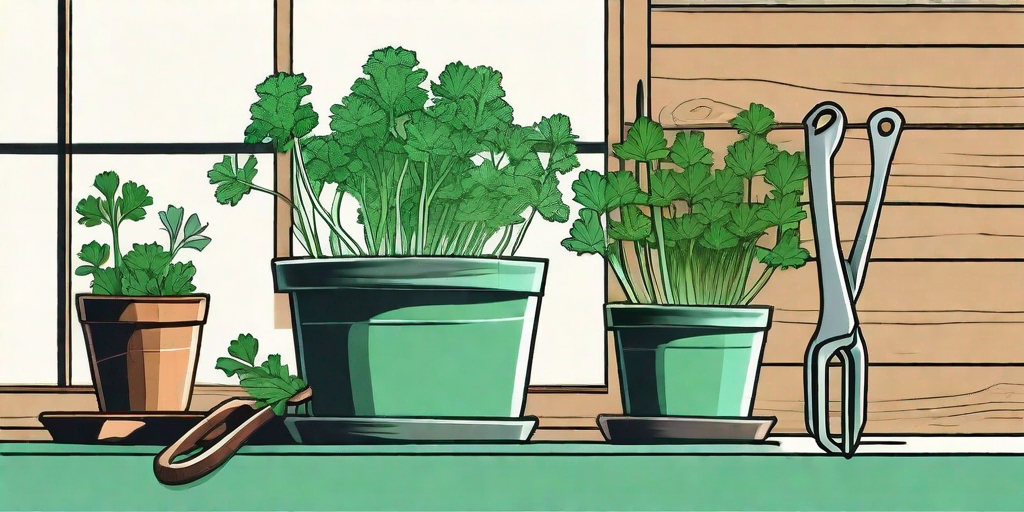
Welcome to the world of herb gardening, where the green thumb meets the culinary arts. Today, we're diving into the leafy world of parsley, a herb that's not just a pretty garnish on your plate but a powerhouse of nutrition and flavor. So, let's roll up our sleeves, get our hands dirty, and explore the wonders of parsley.
The Power of Parsley
Before we delve into the how-to's of harvesting and storing, let's take a moment to appreciate the humble parsley. Often relegated to the sidelines as a mere garnish, parsley is a herb that deserves to be in the spotlight. It's packed with vitamins A, C, and K, and is a good source of iron and folate. Plus, it adds a fresh, vibrant flavor to any dish.
But the benefits of parsley don't stop there. It's also a natural breath freshener (goodbye, garlic breath!), can help control blood pressure, and is even said to have anti-inflammatory properties. Now that's what we call a super herb!
Harvesting Your Own Parsley
Now that we've sung the praises of parsley, let's get down to business. Harvesting your own parsley is a rewarding process that's easier than you might think. Plus, there's something incredibly satisfying about snipping off your own fresh herbs for cooking.
When to Harvest
The best time to harvest parsley is in the morning, when the plant's oils are at their peak. This ensures you get the most flavor and nutritional benefits from your herbs. Look for leaves that are vibrant and green, with no signs of yellowing or wilting.
As a rule of thumb, parsley is ready to harvest when the leaf stems have three segments. This usually happens when the plant is about 6 to 8 inches tall. But don't worry if you're not a plant whisperer - the parsley won't hold it against you if you harvest a little early or late.
How to Harvest
Harvesting parsley is a cinch. Simply snip off the stems near the base of the plant, being careful not to damage the central part of the plant. This encourages new growth and ensures you'll have a steady supply of fresh parsley.
Remember, parsley is a cut-and-come-again plant, meaning the more you harvest, the more it grows. So don't be shy - your parsley plant is like a leafy green Hydra, sprouting two new stems for every one you cut.
Storing Your Freshly Harvested Parsley
So you've harvested your parsley - now what? Well, unless you're planning on using it all immediately (in which case, we applaud your culinary enthusiasm), you'll need to store it. And just like with harvesting, there's a right way to store parsley to ensure it stays fresh and flavorful.
Refrigerating Parsley
The easiest way to store parsley is in the refrigerator. Simply wrap the stems in a damp paper towel, place them in a plastic bag, and pop them in the crisper drawer. This method will keep your parsley fresh for up to a week.
But what if you want to keep your parsley fresh for longer? Well, that's where freezing comes in.
Freezing Parsley
Freezing parsley is a great way to preserve its flavor for longer periods. There are two main methods: the ice cube tray method and the freezer bag method.
The ice cube tray method involves chopping up the parsley, placing it in an ice cube tray, and filling the tray with water. Once frozen, you can pop out the parsley cubes and use them in your cooking. The freezer bag method, on the other hand, involves simply placing the whole stems in a freezer bag and freezing them. Both methods will keep your parsley fresh for up to six months.
Frequently Asked Questions
Can I harvest parsley in the winter?
Yes, you can! Parsley is a hardy plant that can withstand cooler temperatures. Just make sure to harvest it before the first frost, as the cold can affect the flavor of the leaves.
Can I use the stems of the parsley?
Absolutely! While the leaves are the most commonly used part of the parsley plant, the stems are also edible and packed with flavor. They're great for adding to stocks, soups, and stews.
How often should I water my parsley plant?
Parsley likes moist soil, so it's best to water it regularly. However, be careful not to overwater, as this can lead to root rot. A good rule of thumb is to water when the top inch of soil feels dry to the touch.
Conclusion
And there you have it - the ins and outs of harvesting and storing your own parsley. With a little bit of care and attention, you can enjoy fresh, flavorful parsley all year round. So go forth and harness the power of parsley - your taste buds (and your health) will thank you!











